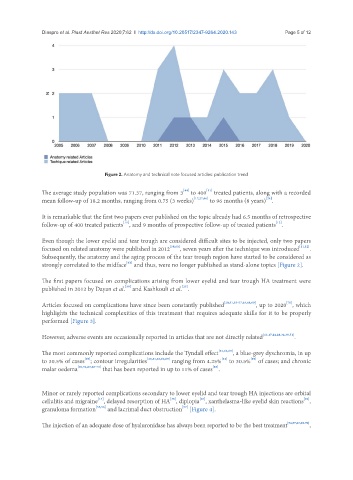Page 729 - Read Online
P. 729
Diaspro et al. Plast Aesthet Res 2020;7:62 I http://dx.doi.org/10.20517/2347-9264.2020.143 Page 5 of 12
Figure 2. Anatomy and technical note focused articles: publication trend
[11]
[44]
The average study population was 71.37, ranging from 3 to 400 treated patients, along with a recorded
[24]
mean follow-up of 18.2 months, ranging from 0.75 (3 weeks) [17,27,66] to 96 months (8 years) .
It is remarkable that the first two papers ever published on the topic already had 6.5 months of retrospective
[12]
[11]
follow-up of 400 treated patients , and 9 months of prospective follow-up of treated patients .
Even though the lower eyelid and tear trough are considered difficult sites to be injected, only two papers
focused on related anatomy were published in 2012 [58,60] , seven years after the technique was introduced [11,12] .
Subsequently, the anatomy and the aging process of the tear trough region have started to be considered as
strongly correlated to the midface and thus, were no longer published as stand-alone topics [Figure 2].
[61]
The first papers focused on complications arising from lower eyelid and tear trough HA treatment were
[25]
[39]
published in 2012 by Dayan et al. and Kashkouli et al. .
[70]
Articles focused on complications have since been constantly published [20,51,53-57,63,68,69] , up to 2020 , which
highlights the technical complexities of this treatment that requires adequate skills for it to be properly
performed [Figure 3].
However, adverse events are occasionally reported in articles that are not directly related [13,17,22,28,32,39,71] .
The most commonly reported complications include the Tyndall effect [51,63,69] , a blue-grey dyschromia, in up
[69]
to 30.5% of cases ; contour irregularities [25,51,53,63,69] ranging from 4.25% to 30.5% of cases; and chronic
[69]
[51]
[69]
malar oedema [20,54,63,68-70] that has been reported in up to 11% of cases .
Minor or rarely reported complications secondary to lower eyelid and tear trough HA injections are orbital
[29]
[13]
[25]
[39]
cellulitis and migraine , delayed resorption of HA , diplopia , xanthelasma-like eyelid skin reactions ,
granuloma formation [55,56] and lacrimal duct obstruction [Figure 4].
[57]
The injection of an adequate dose of hyaluronidase has always been reported to be the best treatment [54,57,63,68-70] ,

